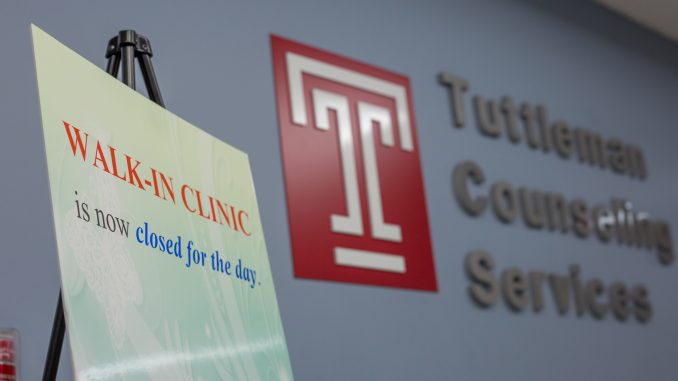
As the number of students visiting Tuttleman Counseling Services increased in the previous school year, so did the average wait time to access the walk-in clinic and schedule additional appointments.
During the 2013-14 academic year, Tuttleman increased its staff by the equivalent of eight full-time staff members, said John DiMino, Tuttleman’s director.
But by the 2015-16 academic year, the number of student walk-ins rose to 3,334, DiMino said, about 34 percent more than the 2012-13 academic year.
Students and administrators said Tuttleman is understaffed, which has led to the majority of complaints about the service.
“There’s simply not enough therapists to go around,” said Brandon Rummel, a freshman history major. Rummel said he used the walk-in service, which “saved” him.
Wait times for walk-in appointments depend on the amount of students using the service on any given day and students could wait for only a few minutes or up to half an hour, DiMino said.
“We try to normalize it,” DiMino said. “We changed the language in our brochures and online to help people to understand that that’s normal in a large college counseling center in a large university.”

After students use the walk-in service, they schedule an “intake appointment,” and the next availability for the counselors could be anywhere from between two to five weeks, DiMino said. Last semester, the wait was usually between four or five weeks, he added.
“That’s where we don’t want to be,” DiMino said. “When we increased our staffing three years ago, we saw everyone that year within two weeks.”
That same year, the source of Tuttleman’s funding changed from an individual line item in the university’s budget to the services fee every student pays as part of their tuition.
Tuttleman has 16 full-time and eight part-time staffers, he added. On any given day, there are usually four or five people working in Tuttleman’s walk-in clinic: at least one senior licensed clinician, a psychologist, junior staff and trainees.
“At the space we’re in now, it’s a real logistical challenge to get everyone to have their office hours with so many part-timers and students in training being here,” DiMino said. Tuttleman is in 1810 Liacouras Walk, which houses the Academic Resource Center, Center for Learning and Student Success and Student Health Services.
Construction in the first floor of Paley Library created space for the advising department of the College of Liberal Arts to move from 1810 Liacouras Walk to the library.
That space, however, is expected to go to the Fox School of Business. Dozie Ibeh, the associate vice president of Temple’s project delivery group, told The Temple News in August that the university plans to empty 1810 Liacouras Walk for the overall expansion of the Fox School of Business and to “create a business school quad zone” with Alter Hall, Speakman Hall and then 1810 Liacouras Walk.
In July, Diana Knudsen, a senior vice dean in the Fox School of Business, said 1810 Liacouras Walk was being renovated in time for the centennial anniversary of Fox in Fall 2018.
To shorten the wait for intake appointments, DiMino and his team are planning group sessions which will serve students who are considered “non-urgent.”
“We’re hoping to have groups running every day starting next fall where we can say, ‘Hey, go to see Dr. so-and-so at noon today and you can get started right away,’” DiMino said.
Even though there are long waits, students continue to use Tuttleman’s services.
“Tuttleman Counseling Center was a great resource,” said freshman pre-health professions major Alex James. “The mind is just like the body. Sometimes you need to get a checkup to make sure everything is okay. … I had anxiety attacks that were crippling, and the center helped me out a ton.”
“We want students to not be waiting a ridiculous amount of time and hopefully we’ll also have less wait for that intake appointment,” DiMino said.
Amanda Lien and Jacob Garnjost can be reached at news@temple-news.com or on Twitter @TheTempleNews.
CORRECTION: An earlier version of this article misstated that “On any given day, there are usually four or five people working in Tuttleman.” It now reads “On any given day, there are usually four or five people working in Tuttleman’s walk-in clinic” for clarity. The article also incorrectly stated that there was “34 percent more [students] than the previous academic year.” The increase was from the 2012-13 academic year, and the story has been updated to reflect this fact.



Be the first to comment